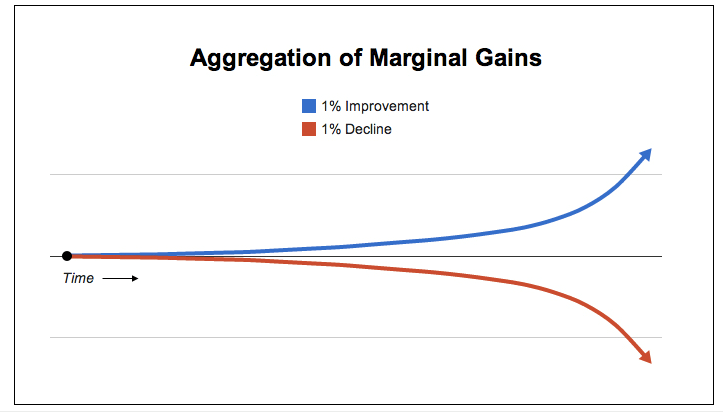Striving for a mere 1% improvement on any given metric might – quite understandably – leave you wondering, why bother?
Surely, a more lucrative approach would be to aim higher. 5%, surely, at the very least – but even 5% has got nothing on improvements weighing in at 10%, 15% or even 25%.
And of course you would be right – and you don’t need to be a mathematician nor indeed some sort of business ‘guru’ to figure out why.
However, consider the overall impact if you were able to improve every single metric associated with your business by just 1%. The aggregate result would indeed be much more impressive than the sum of its parts.
Enter the Marginal Gains Theory
In aggregation, 1% improvements can make a huge difference.
One proponent of the theory is Sir Dave Brailsford – Performance Director of Team Sky, and previously British Olympic Cycling – the man responsible for taking the ailing British Cycling Federation from 2 bronze medals at the 1984 Atlanta Olympics, to the fantastic medal haul of 8 gold, 2 silver and 2 bronze at London 2012, and 6 gold, 4 silver and 1 bronze in Rio 2016.

Image Source: https://careeremployer.com/
How did he do it? By concentrating entirely upon small improvements every single day. Every process, every component, every piece of equipment, every metric – in short everything – Brailsford aimed to improve by a factor of just 1% at a time, as he explained in an interview with the BBC:
“The whole principle came from the idea that if you broke down everything you could think of that goes into riding a bike, and then improved it by 1%, you will get a significant increase when you put them all together.
“There’s fitness and conditioning, of course, but there are other things that might seem on the periphery, like sleeping in the right position, having the same pillow when you are away and training in different places.
“They’re tiny things but if you clump them together it makes a big difference.”
And what a difference it made. By optimising everything from the diet and nutrition of the riders to the ergonomics of the bicycle seat, from training programs to footwear – even from discovering which pillows ensured riders got the best night’s sleep to teaching them the most effective methods of washing their hands to avoid infection – by 2012, Sir Bradley Wiggins became the first British cyclist to win the Tour de France, and the British Cycling Team scooped up 70% of the gold medals available at the Olympics.
Let’s take a moment to take that in – by searching for 1% improvements everywhere they could, the British Cycling Team won 70% of the gold medals available.
70%!
If you need proof of the difference that a focus on marginal gains can make, there it is.
The Importance of Marginal Gains When Growing Your Business
However, let’s just be sure that the message is hitting home. And let’s do so by considering the effects in reverse – i.e. the effects of an aggregation of marginal declines in performance.
A 1% decline today may not be notable or even noticeable. But consider what would happen to your business if you performed just 1% worse every day over a longer period of time…. Yes – suddenly, there’s a problem.
It’s the same effect as a ship or an aeroplane veering just 1 degree off-course over thousands of miles – it will end up a long way from where it wants to be.

(Image source: jamesclear.com)
Now, just to be clear, making the odd mistake every now and again isn’t going bring the administrators knocking down the door. But, nonetheless, the compound effect of repeated declines in performance will ultimately lead to failure.
And so, by contrast, over time, 1% increases in performance metrics will lead to medals and glory – and, as we can see by the brilliant image above from James Clear, the gap between 1% improvers and 1% decliners gets increasingly wider the longer the results are left to aggregate.
Adopting the Optimisation Mindset – Achieving Marginal Gains in Every Quarter
So, how do we apply the marginal gains philosophy to our businesses?
With its focus on data, one area that the marginal gains approach chimes most harmoniously with is of course inbound marketing. Conversion rate optimisation, lead optimisation metrics, email open rates, landing pages, social media followers – the inbound marketer is indeed already firmly focussed on metrical improvements.
But, for a marginal gains approach, we must be concentrating on those small 1% improvements that might normally be overlooked. This is the optimisation mindset that we must adopt.
It would be almost impossible to create a list of all the tiny 1% improvements that you could be making at your business to marginally optimise your processes and workflows. And so, rather than attempting to do so, we’ve created a short list with the purpose of giving you inspiration, rather than strict instructions, on what it’s possible to optimise.
Check it out…
Automate Little Things
How much time could you save over the course of a year if you never had to manually write the name of a recipient at the top of the emails you send? In isolation, you may save all of a few seconds. In aggregation – especially over the whole workforce – you could be looking at hours that could be spent far more valuably. Invest in email software that will help you template emails you find you are sending often.
And what about when you write your blogs? Have you set up a default style that ensures spaces are left between paragraphs of the same style, or are you still having to do this every time you fire up the software? And where does the document get saved? On your hard drive, from where you then have to manually save a copy to a shared folder in the cloud? Take a few minutes today to automate this process and save hours in the long run.
What are the little things that you and your team could be automating for 2017?
A/B Testing
Split testing or A/B testing is one of those things that everyone talks about, but few actually bother with.
Get out of this habit today. From tweets to Facebook posts, from CTA buttons to landing page designs, and from email subject lines to the special offers contained within – everything can be put through an A/B test. If you can improve all of the associated metrics in these things by just 1%, the aggregate value over time is potentially huge.
Then improve by just 1% again (and then do it again (and again!))
Training
How well does your team understand the software tools they are tasked with using every day? What are those little hidden features that not everyone knows about?
The more knowledge your team has, the better equipped they are to improve productivity – even if just by 1% at a time.
Review and Identify Your Most Valuable KPIs
All improvements need a baseline from which performance can be reliably measured.
And these baselines themselves could well do with a few marginal gains.
Conversion rates, though important, are not the be all and end all, and, as such, do not necessarily form the most valuable KPI (key performance indicator). Revenue, new customer acquisition costs, goal value per site visit, bounce rates, reading time spent on your blogs, eBook downloads – all of these things can be micro-measured by segment. The question, however, is how valuable is each one to the success of your particular business model? Mine your data, figure it out, and improve your KPI priorities – and then work on improving the KPIs themselves.
Over to You
Marginal gains aggregate to vast improvements over time.
The first thing you need to do is to write a list of every single factor of your business – and then aim to improve each of those factors by just 1% (or more, if you like) over the course of, say, six months. If there are 100 items on your list, then the overall improvement to your business operations in that time will be massive. And then, the following six months can be devoted to making 1% improvements all over again.
To find out how you can make marginal gains, book your mini or full free marketing consultation today. Just fill in the form on the sidebar now.









